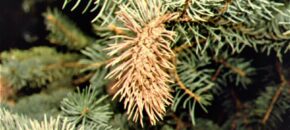Collar rot (Alternaria linariae) or Alternaria stem rot (Alternaria alternata f. sp. lycopersici) of tomato are common in young tomato plants. Either can be particularly troublesome in seedlings that have been held in transplant flats for an extended period of time before transplanting in hot, humid greenhouses. Collar rot infections often start where a leaflet branch has been […]
Continue reading...Landscape Pest Notes for July 2023

Cooley Spruce Gall Adelgid (1850-1950 GDD = galls open): Colorado spruce (especially green forms), Sitka and Oriental spruce, and Douglas-fir share this pest’s two host life cycles. Mature adult females lay eggs at the tips of branches. These eggs hatch and the immatures move to new growth and start feeding. The combined feeding and salivary […]
Continue reading...Controlling Phytophthora blight in cucurbit plantings
As the summer heats up in New Jersey, the control of Phytophthora blight in cucurbit plantings can be extremely difficult (even with the use of fungicides) as hot, wet weather finally sets in. Mitigating losses to Phytophthora blight in cucurbit crops begins with long crop rotations, where recommendations suggest crop rotations longer than 5 years […]
Continue reading...Diagnosing pith necrosis in tomato
Symptoms usually begin to appear on random plants throughout the field as green fruit begins to mature. The bacterium (Pseudomonas corrugata) is ubiquitous to soils and develops when weather conditions (cooler nights/very hot, humid days) and cultural practices (i.e., excess heavy N use) lead to favorable conditions for disease development. Symptoms include the development of […]
Continue reading...Rutgers Tree Fruit IPM Report for July 14, 2023
Peach: Oriental Fruit Moth: A biofix point for OFM was set on 4/10 in both northern and southern counties. All timings for first generation OFM have past. Third generation timings are updated below: OFM 2nd Generation Timing Insecticide Type County/Region Degree Days by 6/30 base 45 Conventional 2100-2200 2350-2450 Diamide 2025-2150 2375-2450 Gloucester – Southern […]
Continue reading...North Jersey Wine Grape Twilight Meeting
North Jersey Wine Grape Twilight Meeting July 18, 2023 5:00 PM – 8:00 PM 610 Perrineville Road Hightstown, NJ 08520 Detailed agenda is forthcoming. Talks will include disease and pest updates, pH and fertility management. Pesticide credits are anticipated. RSVP: Please call or E-mail to Kim Crommelin at 908-788-1338 or kfrey@co.hunterdon.nj.us Light fare […]
Continue reading...